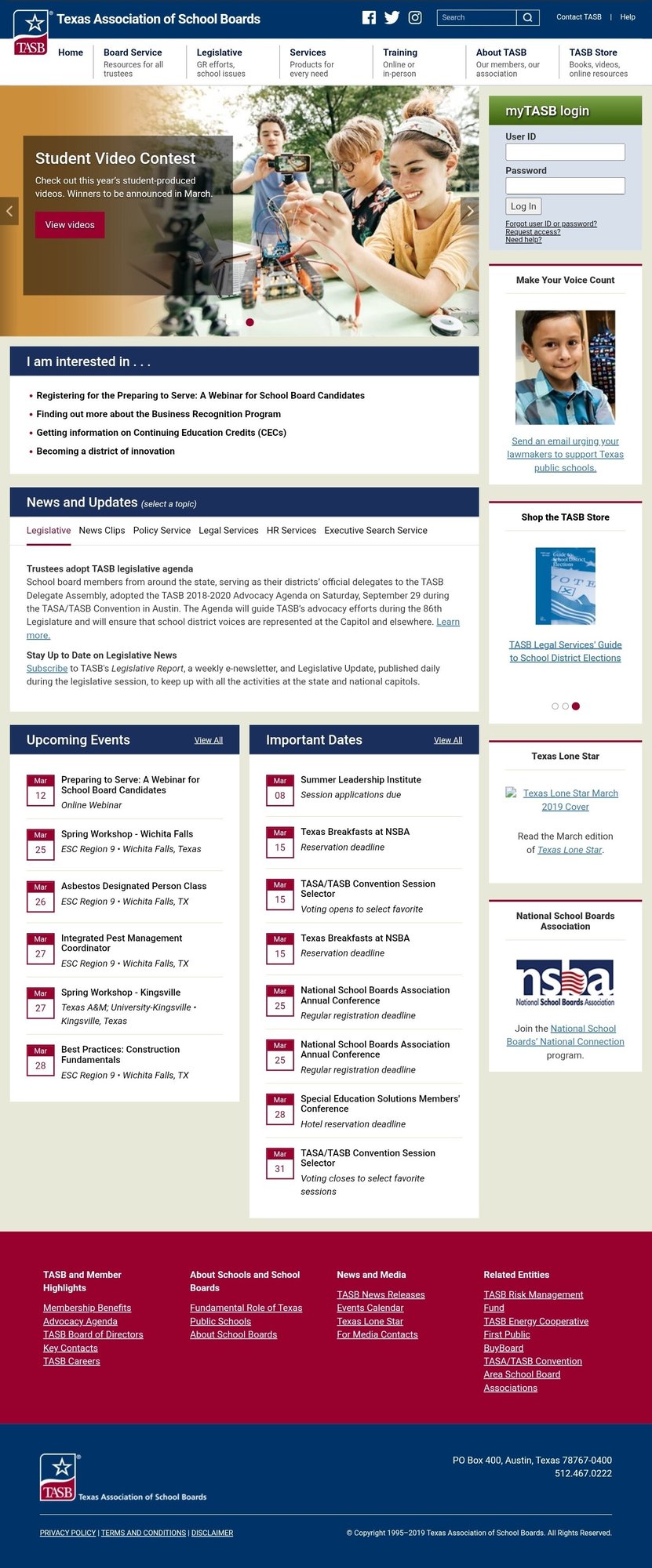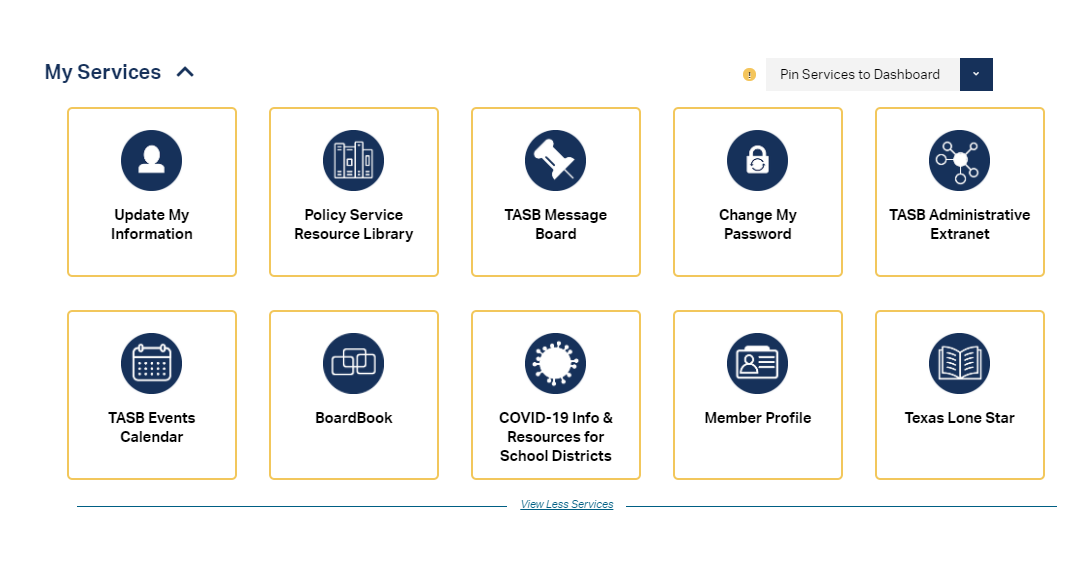Content Strategy
Case Study:
Building a Role-Based Member Center
The Texas Association of School Boards serves school board members and school district administrators. Their siloed site—full of stale pages, hard-to-find resources, and stodgy PDFs—frustrated members who needed quick, accurate guidance. I led the content strategy alongside our Digital Experience and UX team to solve it. We built a Member Center that, once logged in, delivers customized navigation and resources tailored to each member’s role—transforming a frustrating site into a practical, personal hub for school board leaders.
The Issue
The Texas Association of School Boards faced a digital crisis that threatened member service and operational efficiency. TASB's website had become a digital junk drawer.
The association held a huge store of high-value, public-facing content for school board members and district administrators. But with over 1,000 school districts relying on TASB for governance resources, policy information, and guidance, the fragmented content ecosystem—which had grown organically and without any content governance—was failing its membership.
Board members, superintendents, and district administrators—each with distinct professional needs—encountered the same generic experience. Content was siloed across business units and organized by departmental structures rather than audience workflows. A trustee searching for governance training might wade through risk management resources, while superintendents looking for policy updates could end up in HR content.
Pages were not mobile-friendly. Many assets were duplicated or stale, with no clear owner or lifecycle. This fractured content made everyday work harder for members and forced TASB staff to spend more time firefighting than creating additional useful resources or a distribution strategy for those resources.
Communications consultants in each of TASB's different service areas operated with little coordination, often resulting in redundant content. Legal content existed primarily as static PDFs, making updates labor-intensive and limiting use. Poor taxonomy, unclear ownership, and ad-hoc publishing put accuracy and member trust at risk.
With mobile traffic growing and member expectations rising, TASB's website delivered neither the modern, personalized experience members demanded nor the operational efficiency the organization needed.

The Plan
I put together a strategic approach to stop treating content like random collection of individual pages that were sometimes interlinked, and start treating it like a strategic product members could rely on.
-
Establish owner-first content governance: Give MarComm editorial standards and the business areas subject ownership. Communications sets rules, templates, and the review rubric, while service areas keep content accurate day-to-day. Deploy automated content lifecycle controls and expiration reminders, plus legal routing to remove gatekeeping bottlenecks while keeping final accountability roles clear between business areas and MarComm.
-
Treat content like a product (Master Content Model): Define core content items, reusable snippets, and channel containers so each piece has an owner, purpose, metadata, and an expiration date. The model forced TASB to create once and publish everywhere, reducing duplication and accelerating delivery.
-
Headless architecture for multi-channel delivery: Deploy a content-repository approach that separates content from presentation. Enabled TASB to stop publishing PDFs as the primary content type in favor of flexible content pieces that can be recombined and delivered in the formats members need them most. A policy update, for example, can automatically appear with appropriate formatting on the website, in email newsletters, in a mobile app, or even as a PDF, without recreating it each time.
-
Member-centric reorganization: Restructure content organization from internal business lines to member-centric topic clusters with intentional funnels based on audience interests, professional responsibilities and decision-making contexts.
The Work
I laid the groundwork for a comprehensive content transformation that rebuilt TASB's digital ecosystem around member needs:
-
Content research and persona development: Conducted stakeholder interviews across business areas to document objectives and map them to TASB's strategic goals. Working with the UX designer, this research informed the creation of five distinct member personas: School Board Members, Superintendents, Superintendent Secretaries, District Staff (across ten key roles including HR, Legal, Policy, and Risk Management), and the general public. Each persona received detailed journey maps identifying content needs at every stage.
-
Content audit and gap analysis: Led a comprehensive content inventory across hundreds of pages on TASB's digital properties. Each piece was categorized by title, URL, format, author, business goal alignment, and basic analytics. Working with Communications consultants, we applied a three-criteria filter:
-
-
Does it support a business area goal?
-
Does it support organizational strategic goals?
-
Does it help members meet their goals, even if independent of TASB's business needs?
-
Content failing these criteria received closer scrutiny, and in many cases was marked for archival or deletion.
-
Master Content Model development: Designed the content architecture with three layers:
-
Core Content Items (fundamental information like service descriptions)
-
Content Snippets (reusable elements like legal callouts, service descriptions, policy explanations, staff or speaker bios, etc.)
-
Channel Pages (containers assembling pieces for specific audiences)
-
I established controlled vocabularies for taxonomy including topic, persona, and journey stage fields to enable automated personalization and measure content effectiveness.
-
Information architecture and personalization strategy: Restructured content organization from internal business lines to member-centric topic clusters. The Digital Experience team implemented the technical framework while I defined the content strategy for role-based personalization. In other words, the same article about legal changes could display identical background context but show different "What It Means For You" sections tailored to the specific audiences consuming it in the logged-in state, ensuring each reader saw actionable guidance specific to their responsibilities.
-
Content governance and lifecycle implementation: Established the center-out hybrid governance model where MarComm maintains editorial oversight and business areas maintain authority over the subject matter. I created standardized content review processes with regular reviews and potential expirations for un-reviewed content. A spring cleaning audit I designed required all existing content to receive initial three-month expiration windows with automated reminders. Going forward, most content (other than news and magazine content) was held to an annual review, 24 months for legal content (aligning with the state's legislative sessions).
-
Multi-channel content strategy: Developed taxanomic segmentation rules enabling content delivery by role, interest, and buyer journey stage across email and onsite experiences. Working with the Digital Experience team's technical implementation and representatives from various service lines, I defined marketing automation triggers and personalization conditions to surface the right content at the right times, based on self-identified interests, continuing education needs, and district-specific services.

The Results
This project transformed content marketing for TASB, changing the way it was understood by leadership, created by teams, and served members. The TASB Member Center delivered measurable operation gains, but more importantly, better perceived value of membership and overall member engagement with TASB's content.
-
Efficiency: Content creation and review processes became significantly more efficient through the Master Content Model and reusable snippets. The detailed personas and journey maps provided clear direction on what audiences needed at every stage, eliminating guesswork and reducing time spent on content that missed the mark.
-
Content governance and freshness: The spring-cleaning audit plus required expiration fields created a repeatable cadence for content review (the initial 3-month review and remediation window, then annual checks), which reduced the backlog of stale pages and clarified accountability for updates.
-
Member experience: The Member Center's role-aware navigation and consolidated "My Services" dashboard helped members more easily find district-specific information and tools, continuing-education tracking, and service contacts. Single sign-on and personalized action items made the site feel like a workplace assistant rather than a brochure.
-
Scalable platform: A headless content repository with COPE (create once, publish everywhere) made content reuse possible across web, email, apps, and internal tools—so future channel launches require less rework and deliver faster ROI.
The content strategy and execution here shifted TASB from reactive and prone to random acts of content to managing content as a strategically-deployed product. This change gave teams time back for deeper work and provided members with a digital experience that respected their time and their goals.
It's worth noting that we stayed practical throughout this. We thought big, but we started with small iterations, content experiments, regular reviews of what seemed to move the needle, and what took up time without delivering big impact. The result was a calmer publishing process and a Member Center that worked as the helpful tool TASB members needed it to be.